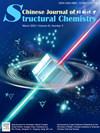A new SIFSIX anion pillared cage MOF with crs topological structure for efficient C2H2/CO2 separation
IF 5.9
4区 化学
Q1 CHEMISTRY, INORGANIC & NUCLEAR
引用次数: 0
Abstract
Due to the similar physicochemical properties of acetylene (C2H2) and carbon dioxide (CO2), separating C2H2 from a CO2/C2H2 mixture poses a significant challenge in the petrochemical industry. Herein, we successfully synthesized a novel SiF62− anion pillared cage metal-organic framework ZNU-15 possessing a new crs topological structure for the selective capture of C2H2. As a linear bidentate linker, the fluorinated SiF62− anion partitions the pores into various sized cages. ZNU-15 displays moderate adsorption for C2H2 with a capacity of 36.0 cm3 g−1 at 298 K and 1 bar, which is 2.7 times higher than the CO2 uptake. The IAST selectivity of C2H2/CO2 for ZNU-15 at 298 K and 100 kPa is 10.5, surpassing that of most reported materials. The Qst values for C2H2 and CO2 at zero coverage are 54.0 and 42.8 kJ mol−1, respectively. Moreover, breakthrough experimental tests show that ZNU-15 is capable of effectively separating C2H2 from a C2H2/CO2 mixture. Theoretical calculations further indicate that C2H2 is preferentially trapped by the small cage with four cooperative hydrogen bonds.

求助全文
约1分钟内获得全文
求助全文
来源期刊

结构化学
化学-晶体学
CiteScore
4.70
自引率
22.70%
发文量
5334
审稿时长
13 days
期刊介绍:
Chinese Journal of Structural Chemistry “JIEGOU HUAXUE ”, an academic journal consisting of reviews, articles, communications and notes, provides a forum for the reporting and discussion of current novel research achievements in the fields of structural chemistry, crystallography, spectroscopy, quantum chemistry, pharmaceutical chemistry, biochemistry, material science, etc. Structural Chemistry has been indexed by SCI, CA, and some other prestigious publications.
 求助内容:
求助内容: 应助结果提醒方式:
应助结果提醒方式:


